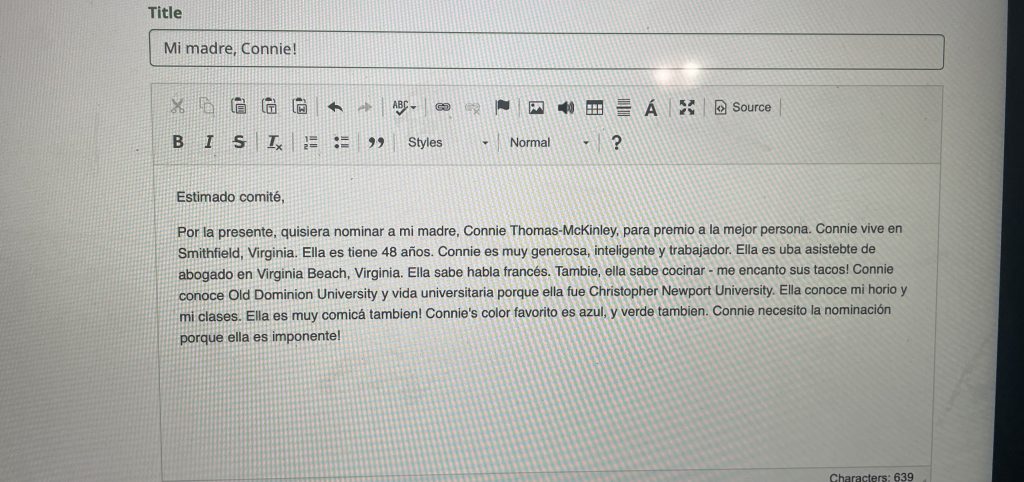Interpretive, Interpersonal, and Presentational Modes of Communication
Instructions
Exploring Culture
Through the course of the class, I was immersed in the Spanish speaking culture by a course requirement within LingroLearning to search multiple different Spanish speaking countries and learn about the culture, be it traditions, schooling, celebrities, and more. These small assessments had a great impact on my learning as it influenced me into looking into different aspects of life I wouldn’t have thought about. The Spanish speaking culture is very interesting! It’s intriguing to learn about how people in certain areas have their own way of speaking (like nosotros v.s. vosotros) and common practices in different regions that aren’t practiced in others (siestas!).
Engaging in Communities
Engaging with the community is very important to me because we truly only have both one world along with one life, and the main goal is to make it safe and happy! Engaging with the community locally allows you to assist people with common problems, and in turn, build strong relationships to where people help you back when needed. This forms a sense of unity within an area and benefits not only one person, but many being the community as a whole. Global engagement is important as well, referring back to the one world point. On the global scale regarding engagement, it allows for people to be more inclined to travel and connect with people, disregarding the fact that people are so different. This also allows for learning of others cultures to flourish, giving people the heightened sense of cohesion and unity.
Interpersonal Communication
One interpersonal communication activity that was conducted during the semester was the “Interview with a Spanish Speaker” project. Personally, I conducted my interview with an old coworker, and it was really neat to be able to have a conversation with him in his own first language. It brought us closer as he was impressed by my ability to speak Spanish! He also encouraged me to reach out to him and ask for his help, as he wants to see me succeed in something he is very passionate about!
Discussion boards and unplanned, spontaneous conversations with myself alone really helped me! Discussion boards improved my spanish understanding, reading and writing, while spontaneous conversations helped me practice speaking while mastering pronunciation. Initially, pronunciation of words was my biggest hardship, but speaking in Spanish to myself while doing chores and other random activities really helped me! Many times on the way to class I would practice speaking aloud to give myself more confidence.
Conversations with friends and strangers alike also helped me with my confidence of speaking! It taught me to stop being afraid of messing up, and just try! If what I was saying didn’t come out fully as intended, Spanish speakers were very inclined to help me! Recently, I’ve been having conversations with coworkers and they are very proud of how far I’ve come within this semester!
Presentational Speaking
As previously mentioned, I got to sit down and interview a coworker while speaking Spanish. It helped me learn how to really communicate and helped with growing my confidence. It also gave me more insight to my coworkers past and he told me tips to learn Spanish!
I excelled at speaking through doing it often. When it came time for my speaking interview with my professor, I was calm because I knew that this is what I practiced and I felt ready! Next time I would try to practice with another Spanish speaker in depth to really get the full effect of conducting a conversation.
Presentational Writing
This blog is a great example! It showcases who I am, along with what I’ve learned throughout the class. I also was tasked with many writing practices and tests to strengthen my knowledge and application.

Throughout the course I had to write many paragraphs about who I am, what my schedule is, and who I nominate for a person of the year award! the photo attached is my submitted writing of who I admire – my mom! Writing about my schedule and who I am as a person was easy from the beginning, but writing about others was hard for me. I practiced with the words and got comfortable with them after time. Letters like ñ, é, á were hard at first, but memorization helped me a lot with specifics. Next time, I plan on really pushing to memorize the spelling of the words, as that is still a struggle for me.
Interpretive Listening
During the semester there were many LingroLearning activities that focused on listening to a conversation or word and responding to it. Also, during class there was a listening quiz on the alphabet, and videos played where people were talking in Spanish.

Attached is one of the listening quizzes that was presented in the beginning of the semester (saved on my computer because the powerpoint was saved). It was not challenging to me because I was confident in my letter-understanding abilities! I thought it was cool that I could understand letters in a different language and figure out what the word they are spelling is! It certainly helped me understand Spanish better. Videos presented in class helped because I could use visual context clues (pointing, body language) to understand what the person speaking was trying to convey.
Interpretive Reading
As mentioned, throughout the semester LingroLearning prompted us to do research on countries, people and parts of the Spanish culture. One thing it encouraged, was looking these things up in a Spanish orientated search engine.
https://www.uam.mx
One activity within LingroLearning was to search a university that was in a Spanish speaking region – my chosen one was the Universidad Autónoma Metropolitana (linked above). I found it confusing trying to navigate a website completely in Spanish, but once I realized, “wow, I actually know a couple of words”, I felt more confident. My takeaway was feeling more confident in my understanding of Spanish words. I’ve grown a lot through these exercises!